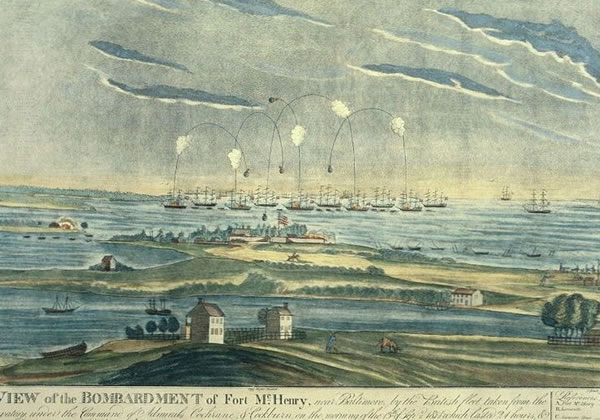
Siege of Baltimore |
A Turning Point
The siege and bombardment at Baltimore in 1814 was the turning point in the War of 1812. After routing American forces at the Battle of Bladensburg, and subsequently burning Washington to the ground, British land and naval forces hoped to further demoralize the Americans by destroying port of Baltimore.
The British Attack Baltimore Harbor
The well-fortified city of Baltimore was under the command of Samuel Smith. The British initially chose to attack by land, but American defenses were much stronger than anticipated. Furthermore, British Commander Robert Ross was killed during the British excursion, and the decision to attack Fort McHenry in Baltimore Harbor was made. American forces concentrated in and around Fort McHenry to prepare to defend it against the impending attack. Before the battle, commander of the fort George Armistead, ordered the sinking of a line of American merchant ships to prevent British ships from gaining access to the harbor.
The Americans Refuse to Surrender
On the night of September 13, 1814, British naval forces began firing shells and rockets at Fort McHenry. The bombardment continued for more than 27 hours. During the bombardment, Francis Scott Key, who was a temporary British prisoner, became inspired to write the Star-Spangled Banner on the back of an envelope. He originally named his poem "Defense of Fort McHenry." When it became apparent the Americans would not surrender the fort, British forces withdrew from the region and set their sights on New Orleans.
War of 1812 Battles |
| November 7th, 1811 - Battle of Tippecanoe |
| July 17, 1812 - Battle of Fort Mackinac |
| August 15, 1812 - Massacre at Fort Dearborn |
| October 13, 1812 - Battle of Queenston's Heights |
| January 22, 1813 - Battle of Frenchtown |
| March 30, 1813 - Battle of Lacolle Mills |
| April 27, 1813 - Battle of York |
| May 1-9, 1813 - Siege at Fort Meigs |
| August 15-16, 1813 - Surrender of Fort Detroit |
| September 10, 1813 - Battle of Lake Erie |
| October 5, 1813 - Battle of Thames |
| 1813-1814 - Creek War |
| July 5- 1814 - Battle of Chippawa |
| July 25, 1814 - Battle of Lundy's Lane |
| August 24, 1814 - Battle of Bladensburg |
| August 25, 1814 - The Razing of Washington |
| September 6-11, 1814 - Battle of Plattsburgh |
| September 12-14, 1814 - Siege of Baltimore |
| November 11, 1814 - Battle of Crysler's Farm |
| January 8, 1815 - Battle of New Orleans |
|
|
|